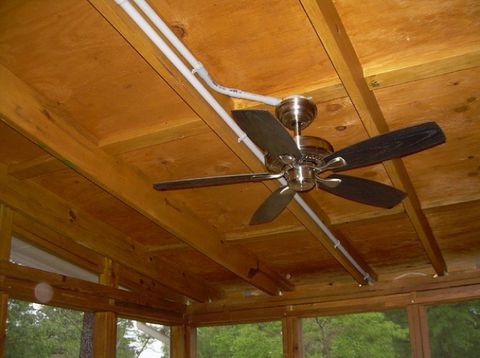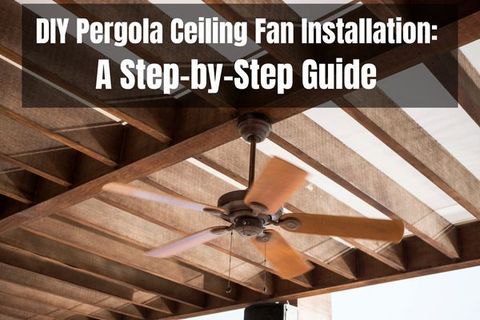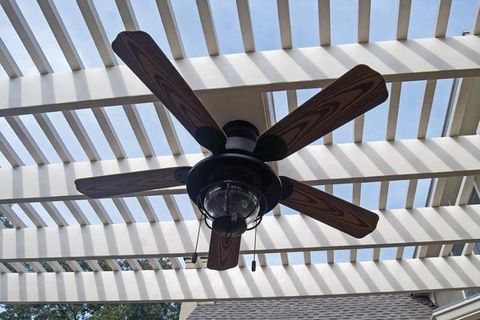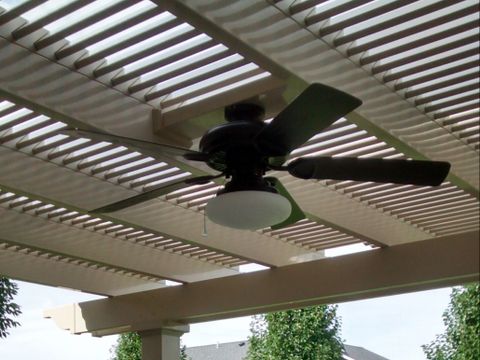Picture this: You’ve just finished building your dream pergola, complete with all the right materials and the perfect design. But when summer hits, you realize that while the structure offers shade, it’s still too hot to enjoy your outdoor space. That’s where ceiling fans come in – but how do you make them work effectively above your pergola? It’s not just about hanging a fan up there. There’s a whole science to maximizing airflow when mounting ceiling fans above pergola structures.
Outdoor living spaces have become increasingly popular, especially in warmer climates. Pergolas offer that perfect blend of shade and openness, creating ideal spots for entertaining and relaxation. But even with all that beautiful woodwork and lattice, heat can still build up in these spaces. Enter ceiling fans – they’re not just for indoor rooms anymore. Installing them above pergola structures can transform a stuffy outdoor area into a refreshing retreat. However, it’s not as simple as just hanging a fan. The positioning, type, and installation method all play crucial roles in how well your fan will perform. What if we told you that with the right approach, you could get better airflow than you ever imagined possible?
Understanding Pergola Airflow Challenges
Pergolas present unique challenges for airflow that differ significantly from standard indoor environments. The open structure means air moves differently, often creating turbulence and uneven circulation patterns. When you’re dealing with a pergola, the fan’s effectiveness depends heavily on how well it can move air through the gaps in the structure. Think about it – a traditional indoor ceiling fan pushes air downward in a circular motion. But above a pergola, that air has to navigate around wooden beams, slats, and open spaces. This creates what experts call ‘air disruption zones.’ These are areas where the airflow becomes chaotic, sometimes even creating dead spots where no breeze reaches. To combat this, you need to consider not just the fan itself, but how it interacts with the entire pergola system. The key insight is that a fan above a pergola works best when it can move air both upward and outward, not just straight down.
Choosing the Right Fan for Outdoor Pergola Use
Not all ceiling fans are created equal, especially when it comes to outdoor applications. You’ll want to look for fans specifically designed for outdoor use. These typically feature weather-resistant materials like aluminum or plastic blades, rust-proof motors, and protective coatings against UV damage. The blade pitch matters too – fans with steeper blade angles tend to move more air, which is crucial when you’re working with open-air conditions. Consider a fan with at least 52 inches in diameter for larger pergolas, or smaller options for intimate spaces. The motor quality is equally important. Look for fans with high-quality motors that can handle continuous operation without overheating. Some manufacturers even offer fans with built-in LED lighting that can be controlled separately from the fan speed. For pergola installations, you might also want to consider a fan with a reversible motor, allowing you to change the direction of rotation based on the season. In winter, you’d want the fan to pull air up and circulate it back down, while in summer, you’d want it pushing air downward for a cooling effect. The right fan choice can make the difference between a barely effective setup and one that truly transforms your outdoor experience.
Proper Mounting Height and Positioning
Mounting height is one of the most critical factors in achieving optimal airflow. For pergola installations, you want to position your fan at least 9 feet above the ground to ensure air movement reaches people sitting or standing below. This isn’t just about safety – it’s about effectiveness. If your fan is too low, it creates uncomfortable wind gusts rather than gentle breezes. The ideal placement is usually 10-12 feet above the ground, depending on the size of your pergola. But positioning isn’t just about height – it’s about where exactly you mount the fan within the pergola structure. Ideally, you want to place it in the center of the covered area, away from any structural elements that might block airflow. If your pergola has multiple sections or spans, consider installing multiple fans for even coverage. The mounting hardware is also essential. You’ll need sturdy brackets designed for outdoor use that can support the weight of the fan and handle wind loads. Some pergolas have pre-installed mounting points, while others require custom brackets. The key is ensuring that whatever you choose can handle not just the weight of the fan but also the forces exerted by wind and temperature changes. A poorly mounted fan can become dangerous during storms or strong winds.
Optimizing Blade Design and Rotation Direction
The blade design of your ceiling fan plays a major role in how efficiently it moves air. Blades that are wider and more curved generally move more air than narrow, straight blades. However, in a pergola environment, you also need to consider how the blades interact with the existing structure. Some fans feature blades with a slight curve or twist that helps direct airflow more effectively. The rotation direction is equally important. During summer months, you want the fan to rotate counterclockwise to push air downward, creating a cooling breeze. In winter, reversing the direction to clockwise helps pull hot air from the ceiling down toward the living space. This is particularly effective in pergola structures where air tends to rise and accumulate. Many modern fans come with remote controls or wall switches that make it easy to change directions seasonally. Some advanced models even have automatic sensors that detect temperature and adjust rotation accordingly. You might also consider using a fan with adjustable blade angles, which allows you to fine-tune the airflow pattern based on the time of day or weather conditions. The goal is to maximize the volume of air moved while minimizing energy consumption and noise levels.
Managing Wind Patterns and Air Circulation
A pergola’s unique structure creates its own wind patterns that can either help or hinder your fan’s performance. Understanding these patterns can dramatically improve your results. Cross-breeze from adjacent buildings or trees can actually enhance your fan’s effectiveness when properly positioned. The key is to avoid placing your fan directly in line with strong prevailing winds, which can create turbulence and reduce efficiency. Instead, position it where it can work with natural airflow rather than against it. Consider the orientation of your pergola – north-facing areas may receive different wind patterns than south-facing ones. If you notice that certain areas of your pergola stay hotter than others, you might need to adjust the fan’s position or add additional fans. Sometimes, the solution isn’t just about the fan itself, but about the entire microclimate of the space. Adding elements like water features or strategically placed plants can help manage local temperatures and improve overall comfort. The interaction between your fan and the surrounding environment creates a complex system where every element affects the others. It’s like conducting an orchestra – each component needs to be perfectly tuned to create harmony. Pay attention to how the air moves around the pergola structure during different times of day, and adjust your fan settings accordingly. Morning breezes might require different settings than evening air circulation.
Maintenance and Longevity Tips
Outdoor ceiling fans require special care to maintain their performance and longevity. Regular cleaning is essential – dirt and debris can accumulate on blades and affect balance, leading to wobbling and reduced efficiency. Clean the blades at least twice per season using a soft cloth and mild soap. Check the mounting hardware periodically for signs of loosening or corrosion, especially after severe weather events. Lubricate moving parts according to manufacturer instructions, typically once or twice per year. Inspect electrical connections regularly to ensure they remain secure and protected from moisture. Weatherproofing is crucial – some fans come with covers or seals that protect internal components from rain and humidity. Consider investing in a fan with a lifetime warranty or extended protection plan, especially if you live in an area with harsh weather conditions. If you notice unusual noises or vibration patterns, it’s time to have the fan serviced. Proper maintenance not only keeps your fan running efficiently but also prevents costly repairs or replacements down the road. Think of it as an investment in your outdoor comfort that pays dividends for years to come. Some people even set reminders on their calendars to check their pergola fans monthly, treating it like a regular part of home maintenance rather than an occasional chore.
Real-World Examples and Case Studies
Let’s take a look at some actual installations that demonstrate the principles discussed. One family in Phoenix installed a 56-inch outdoor fan in their pergola and found that positioning it 11 feet above ground with a 10-foot span between beams created the perfect cooling zone. They used a fan with a reversible motor and adjusted the direction based on seasonal needs. Another example involved a restaurant owner in Austin who had a large pergola covering a dining area. By installing two fans spaced evenly across the structure, they achieved uniform airflow throughout the entire space. Their solution was to mount one fan slightly higher than the other, creating overlapping air currents that eliminated dead spots. A third case involved a homeowner in Florida who experienced issues with wind damage to their fan. They switched to a model specifically rated for high-wind conditions and added extra mounting hardware, resulting in a much more stable and reliable setup. These examples show that success often comes from combining proper planning with attention to detail. Every pergola is different, so what works for one space might not work for another. The key is understanding the fundamentals and adapting them to your specific situation. Even small adjustments can make a big difference in comfort levels and overall satisfaction.
Maximizing airflow above pergola structures isn’t just about installing a fan and hoping for the best. It requires thoughtful consideration of multiple factors including fan selection, mounting height, blade design, and environmental interactions. The good news is that with the right approach, you can transform your outdoor space into a comfortable retreat regardless of the weather. Whether you’re dealing with a small garden pergola or a large commercial structure, these principles apply. Remember that it’s not just about moving air – it’s about moving it effectively and efficiently. Start with the basics: choose the right fan for outdoor conditions, position it correctly, and maintain it regularly. Then, fine-tune based on your specific environment and needs. The investment in proper airflow setup pays off in comfort, energy savings, and extended enjoyment of your outdoor space. Don’t let a hot summer afternoon ruin your plans because you didn’t think about airflow. With careful planning and execution, your pergola can become a cool sanctuary that extends your living space beyond the walls of your home. The key is understanding that outdoor airflow is a complex system that requires both scientific knowledge and practical experience to master. And honestly, once you get it right, you’ll wonder why you ever put up with stuffy outdoor spaces.














